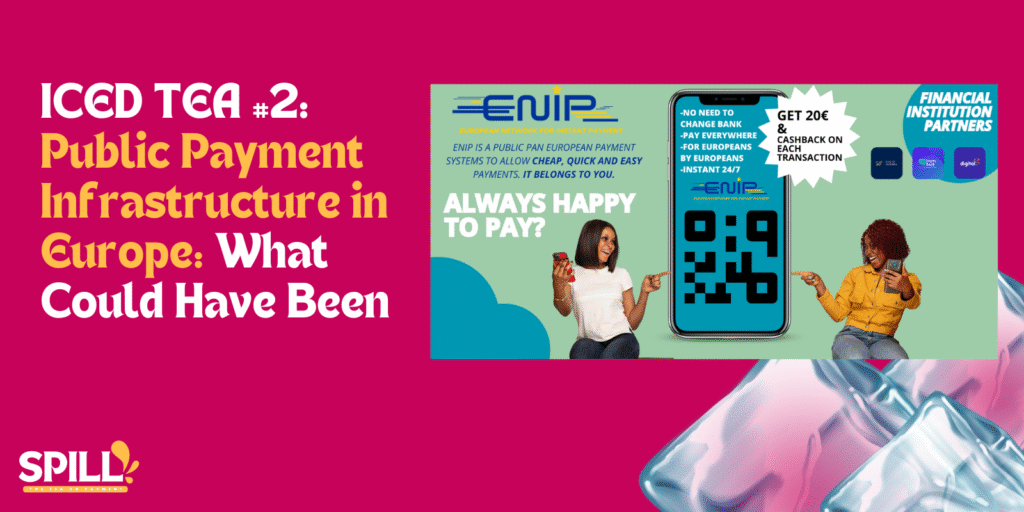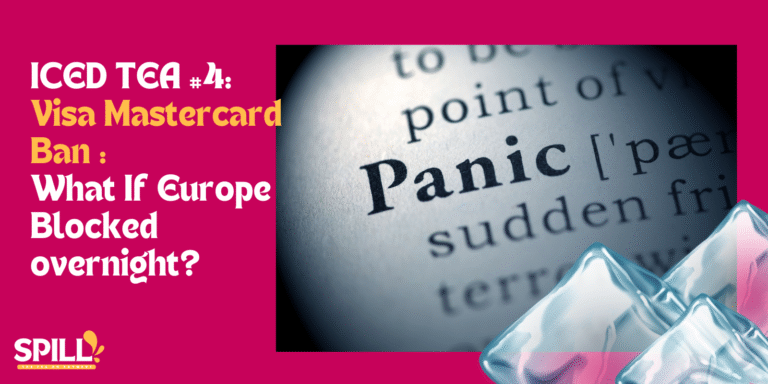Imagine if, back in the early 2000s, Europe had made a different choice. Instead of encouraging integration through regulation alone, we had built a Public Payment Infrastructure in Europe, a truly public scheme. We dared to publicly admit that how money moved was an important matter for Europeans. We could advocate for a shared payment backbone, governed collectively, designed to serve everyone.
Imagining this past that never was isn’t nostalgia, more a thought-provoking exercise. Because the question isn’t just why we didn’t do it, but what that decision reveals about how we see payments today in Europe.
It’s a bold and provocative topic. Especially in a payments industry that applauds UPI or Pix abroad, both public infrastructure, but have real struggles to imagine the same idea of public infrastructure at home.
What if payments weren’t a competitive product, but a civic utility like electricity or rail?
Two Decades of Regulation Without a Scheme
Europe has spent two decades regulating retail payments :
- We unified formats (SEPA)
- We enforced instant payment at low fees (SCT Inst)
- We capped the interchange
- We granted access to non-bank players (PIs, EMIs)
- We designed RTGS systems, roughly saying the rails (TARGET2, TIPS)
- We even proposed a digital euro
But the very simple idea of creating a scheme is taboo. We never created a scheme: a unified, pan-European framework that defines how retail payments happen, from A to Z. How user experience, customer onboarding, and dispute resolution should be made. Not just the rails where commercial banks exchange money with each other.
I am talking about a real public payment infrastructure owned in Europe, designed in the interest of Europeans.
As a result, Europe remains dependent on private schemes, Visa, Mastercard, and increasingly Big Tech for Retail Payments. These are not public utilities; they are relying on market-driven logic, sometimes disconnected from the basic needs of Europeans.
Meanwhile, initiatives like the digital euro reinforce the gap. They are designed as a “monetary instrument”, and not as a user-facing scheme. Authorities in Europe assume this position and leave to the market the capacity to organise, as well as the governance. No rules. No vision. Just plumbing. Just another payment instrument, “just in case” as Mrs Lagarde, governor of ECB said in an interview.
We Know How to Govern Essential Infrastructure. Except Payments
We, Europeans, understand the value of vital public infrastructure. In every essential sector, we accept that competition can exist, but only on top of guaranteed, fair, and publicly governed access. Infrastructure is not just a service, it’s a shared foundation. And when it matters, we organize ourselves to protect it.
Take the following examples across sectors:
- Electricity: The grid is publicly owned by Member States. Providers compete to sell electricity but the wires are public, and access is regulated.
- Trains: Infrastructure is funded and coordinated by entities that, in one form or another, remain public. Operators own the trains not the tracks.
- Water: Pipes are public. Private concessions may manage distribution but with strict obligations and public oversight.
- Roads: Still publicly owned. Even where tolls apply, concessions are granted under public terms, with enforceable obligations.
These systems are not perfect. They are fragmented. They evolve slowly. But they are governed as public goods.
And one principle remains constant: Access is guaranteed, costs are controlled, and a binding authority can intervene.
Because these systems connect us. And failure or abuse is unacceptable.
In contrast, with payments where coordinated fragmentation and a total lack of public interoperability are considered normal. Where there is no public right of access, no baseline guarantee, no body with the power to impose rules in the name of the public interest.
The Risks Are Real, and Already Visible
Recent events have already exposed how fragile things can be. A major power outage in Spain showed how deeply interconnected digital systems are, and how quickly it can disrupt everyday services
The same is true for payments. Visa and Mastercard have both experienced service outages in recent years, leaving millions unable to pay. When these gatekeepers falter, there’s no fallback. And there’s no public guarantee. Payments “work” in Europe until they don’t. And when they don’t, the lack of public alternatives becomes a systemic risk. Let’s try to picture that :
- A geopolitical crisis that blocks card scheme access
- A platform war where mobile wallets delist certain issuers
- A breakdown in cross-border refunds, fraud handling, or acceptance
Certainly, these aren’t dystopias, they’re real dependencies that shape our lives. We don’t own the rails, and we have no shared agreement on how the service should be for citizens. Right now, the winners are the gatekeepers, the ones who own schemes, set rules, and monetise access:
- Global card networks
- Big tech wallet providers
- Acquirers and PSPs who shape the experience
The losers, all the users of the service.
- Merchants, especially SMEs, who face fragmented acceptance and opaque fees
- Consumers, with limited choice and poor cross-border continuity
- European institutions, who have no leverage in shaping the future
How can a system be designed to penalise its users? Even the digital euro, which could have shifted the balance, avoids the governance question. It delegates UX, onboarding, and functionality to private PSPs, reinforcing the idea that money must pass through private toll gates.
Public Infrastructure Isn’t Anti-Market. It Enables It
This isn’t about banning the private sector. It’s about designing truly public base layers, a public payment infrastructure in Europe. Europeans would own it, for Europeans. We could let the private sector build on top. Like UPI in India or Pix in Brazil, it’s not anti-market. It’s pro-access. It creates a level playing field for all actors in the playfield, whether you are big acquirers or small PSPs. Public schemes do not “select” their users; you can access the network as long as you have a licence, and you accept the rules of the games.
Retail payments needs a public scheme, B2B doesn’t
- Retail is messy: hundreds of millions of users, higher risk of fraud, more potential for fragmentation due to the high level of competition between actors
- Trust matters: refunds, disputes, consumer rights
- Fragmentation hurts: no unified rulebook, branding, or access
B2B doesn’t need this: structured invoices, known parties, lower volume. But retail does, especially in a continent of 27 markets, multiple languages, and no default standard.
The Real Barrier Is Political, Not Technical
This part of the story is not technical; it’s political. Europe had all the tools to act and several windows of opportunity. And legally, nothing stood in the way. The European treaties allow for the creation of shared infrastructure in the public interest, including in finance. The ECB could have initiated a scheme. Member States could have backed it. But they didn’t. Not because they couldn’t. But because they wouldn’t.
The answer isn’t lack of means. It’s a lack of will. In Europe, we had multiple moments for Public payment infrastructure :
- SEPA could’ve been a scheme, it became syntax.
- PSD2 could’ve structured governance; it structured access.
- The digital euro could’ve been the UX layer, it stayed a currency layer.
The absence of a public scheme is not a failure of competence. It’s a failure of political vision. A choice , conscious or not to leave the foundations of everyday European life to private actors with no public mandate.
And it continues, even as digital payments become the default, policymakers retreat behind technocratic arguments. As if building a Public payment infrastructure in Europe was a technical task, not a democratic one. As if coordination, neutrality, and access were things best left to the market. Public infrastructure is never just a matter of efficiency. It is a matter of democracy.
Each time, we want to guarantee interoperability but without ownership. Infrastructure but without the right experience. Plumbing but without the policy.
Will Europe Wait for a Crisis to Act?
The ECB’s mandate didn’t help tasked with efficiency, not direction, national governments deferred. The market “worked.”, until it didn’t. In Europe, we tend to move only when we have to, because of a scandal, a failure. But waiting for a crisis is a poor design principle, especially when such vital infrastructure is concerned.
We’re not asking Europe to ban innovation. We’re asking it to take ownership of the foundations. To admit that some things like payments, are too essential to outsource entirely.
Still, likely, action will only come when something forces our hand. A scheme withdrawal, a major cyberattack, a political rift, or a monopolistic chokehold on access. These moments can shake assumptions, but by then, the damage is already done. The real question is: why do we wait at all?
The debate isn’t about technology. It’s about imagination and courage
So let’s ask again: What if we had built it?
And maybe next time: Why haven’t we?
🧃 This was Iced Tea, a fictional chill for a hot summer.
One idea. Many consequences. No easy answers.
You can read the previous episode, clicking here.
See you next week for another glass.










